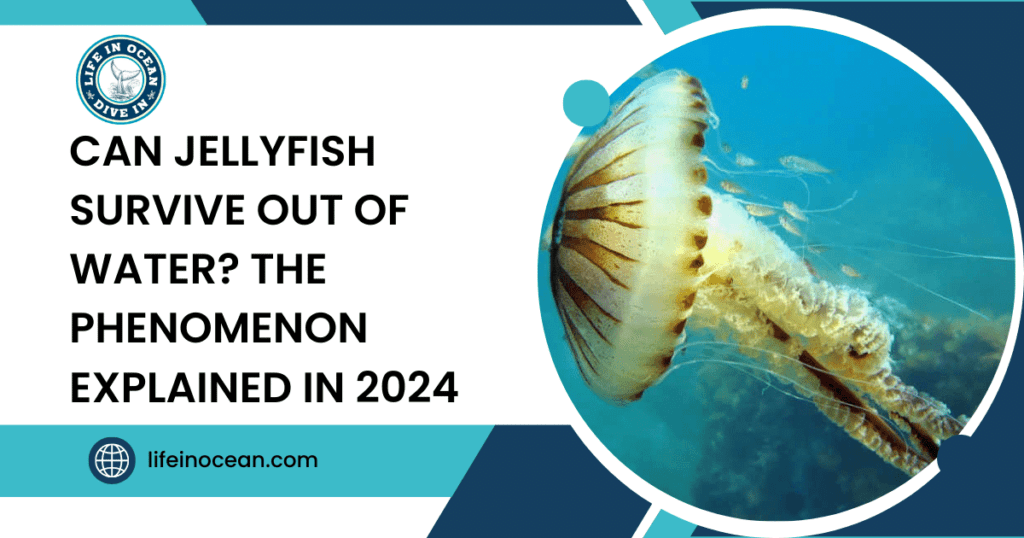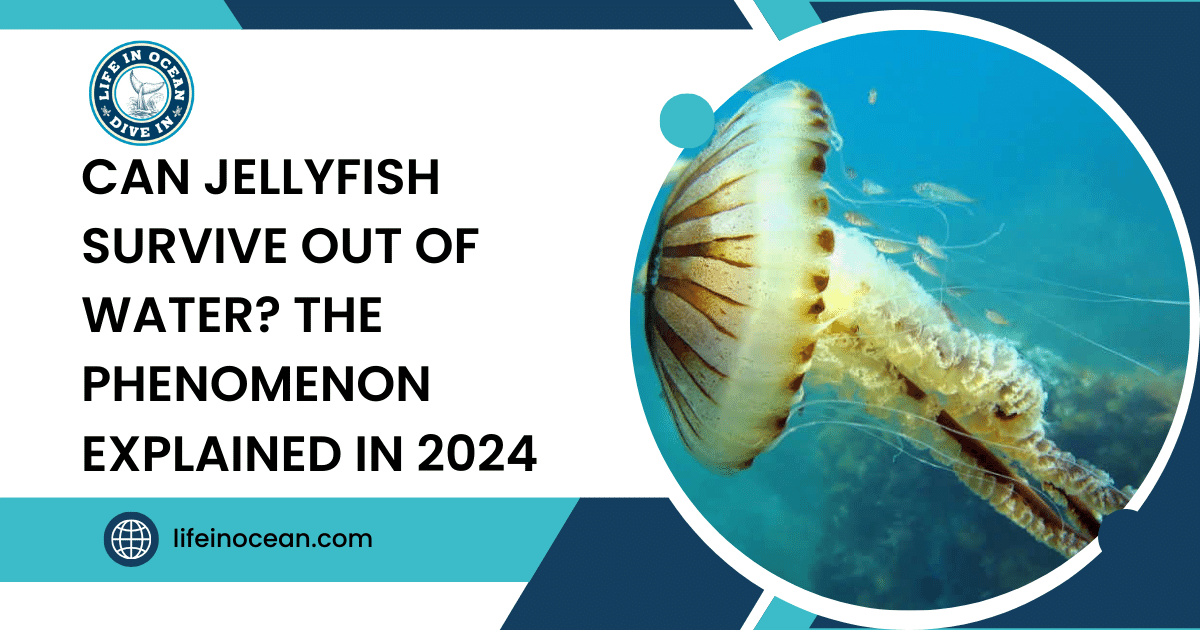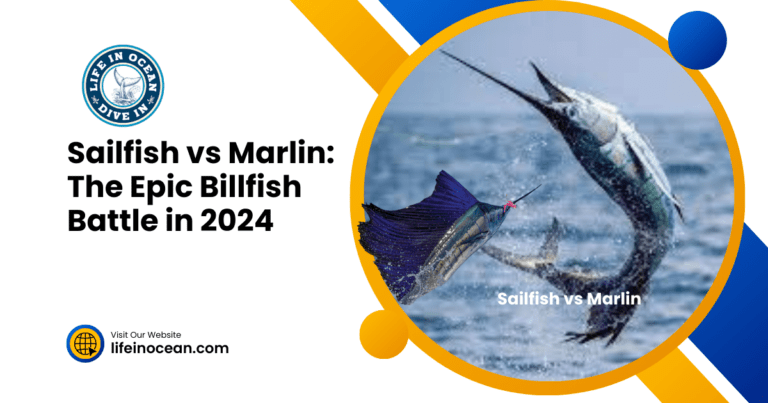Jellyfish, fascinating creatures of the sea, often leave us in awe with their ethereal movements. But have you ever wondered if they can jellyfish survive out of water? The answer might surprise you. In this post, we’ll delve into the remarkable abilities of jellyfish and uncover the truth about their survival outside their aquatic habitat.
Jellyfish have been thriving in seawater for over 500 million years, adapting to various environmental conditions along the way. Their unique biology equips jellyfish larvae with astonishing capabilities that challenge conventional notions of marine life. Join us as we explore the extraordinary world of jellyfish and unravel the mystery behind their potential survival beyond the water’s edge.
Table of Contents
The Basic Anatomy of Jellyfish and Water Dependence
Gelatinous Structure
Jellyfish are made up of a gelatinous umbrella-shaped bell, seawater, and trailing tentacles. Their bodies consist of 95% water, making them highly reliant on the aquatic environment for survival. This composition is crucial to their ability to thrive in water.
Jellyfish propel themselves by contracting and relaxing their bell, allowing them to move through the water. This movement is essential for various vital functions such as finding food and avoiding predators. Without this constant propulsion, jellyfish would struggle to survive in their natural habitat.
The jelly-like consistency of their body also plays a significant role in buoyancy, enabling them to stay afloat effortlessly in the aquatic environment. When out of water, the lack of support from surrounding liquid makes it difficult for jellyfish to maintain their shape and function properly.
Life Cycle Adaptation
Throughout different stages of their life cycle, from polyps to adults, jellyfish larvae develop specific adaptations that allow them to thrive within an aquatic setting. These adaptations are closely linked with the structure of their skin and its interaction with water.
In essence, while some organisms can survive out of water due to evolved mechanisms or specialized organs, jellyfish heavily rely on being immersed in an aquatic environment due to the fundamental makeup and functioning of their bodies.
Jellyfish Out of Water: Can They Survive?
Dehydration and Overheating
Jellyfish, when stranded on beaches, encounter significant challenges such as dehydration and overheating. These creatures rely on the surrounding water to maintain their bodily functions. When exposed to the air for extended periods, they struggle to retain moisture and are at risk of drying out.
Some species of jellyfish have developed unique survival strategies that enable them to endure brief periods out of water. For example, certain types can enter a state of dormancy or stasis when faced with unfavorable conditions like being stranded on a beach. During this dormant phase, their metabolic processes slow down significantly, allowing them to conserve energy until they are submerged in water again.
Buoyancy Support and Maintenance
Without the support of water buoyancy, jellyfish find it challenging to maintain their shape and function effectively. In water, jellyfish rely on its supportive nature to keep their delicate structures intact and move gracefully through the currents. However, once out of the water environment, they struggle to maintain their form due to a lack of support from oxygen-rich currents and pressure.
In essence, while some jellyfish species exhibit remarkable resilience by entering states of dormancy when stranded outside water temporarily; without access to buoyant support from oxygenated waters or rain currents that help sustain their structure and function underwater — they face formidable challenges in surviving prolonged exposure away from their aquatic habitat.
The Phenomenon of Jellyfish Stranding on Beaches
Causes of Strandings
Jellyfish strandings happen when strong currents or storms push them onto shorelines. Mass beachings often coincide with seasonal changes or disruptions in oceanic conditions, which can be caused by wind patterns and sun exposure. These events can lead to certain geographical features that contribute to large numbers of jellyfish becoming stranded.
Strandings are a common sight on beaches, where these sea creatures end up out of their natural habitat due to the forces of nature. When jellyfish are pushed ashore by powerful currents, they find themselves unable to survive without the support of the seawater. This phenomenon is also influenced by disruptions in their food chain and environmental factors such as temperature variations and water salinity.
Impact on Jellyfish Survival
For species adapted to life in the waters, being stranded on land for an extended period poses a significant threat. Reports suggest that many jellyfish cannot survive out of water for too long due to their specialized biological makeup tailored for life at sea. As a result, mass strandings usually have detrimental effects on local marine ecosystems and may serve as signs indicating imbalances in oceanic conditions.
Environmental Factors Leading to Jellyfish Beachings

Impact of Climate Change
Rising sea temperatures can significantly affect jellyfish distribution and behavior. As the waters warm, jellyfish may be more inclined to move closer to shore, increasing the likelihood of wash-ups on beaches. This shift in their habitat is a result of climate change, which directly impacts the marine environment.
Pollution and Nutrient Runoff The influx of pollutants and nutrient runoff into coastal waters can lead to blooms or large populations of jellyfish. These blooms are often responsible for mass strandings as they increase the chances of jellyfish being washed ashore. Human activities such as industrial waste discharge and agricultural practices contribute to this environmental issue.
Influence of Ocean Currents and Wind Patterns
Altered ocean currents and wind patterns play a crucial role in determining the frequency of jellyfish beachings. Changes in these natural phenomena can cause jellyfish to be carried toward coastlines where they become stranded due to unfavorable conditions or reduced water levels during low tides.
- Rising sea temperatures impact jellyfish distribution.
- Pollution leads to blooms, increasing mass strandings.
- Altered ocean currents influence jellyfish wash-ups.
Human Encounters with Beached Jellyfish
Stinging Capabilities
Beachgoers must beware as some jellyfish species can still sting when stranded. Even dead jellyfish with intact tentacles pose a threat to unsuspecting individuals. People must avoid any form of contact with beached jellyfish, whether alive or deceased, to prevent potential stings.
It’s important to note that even though these creatures are out of their natural habitat, their tentacles can still deliver painful stings. Therefore, beach visitors need to exercise some time toward caution and refrain from touching or stepping on stranded jellyfish.
Reporting Sightings
If you come across beached jellyfish while at the beach, reporting these sightings is beneficial for monitoring and research purposes. By informing local authorities or marine conservation organizations about such occurrences, you contribute valuable data that aids in understanding the patterns and reasons behind these events.
Reporting sightings also supports ongoing efforts in studying the behaviors and survival mechanisms of different jellyfish species when they are stranded on beaches. This information is vital for developing strategies aimed at protecting both human beachgoers and marine life.
The Potential for Stings from Beached or Dead Jellyfish
Active Stingers
Even after death, some jellyfish species’ stingers can remain active for a period of time. If you come into contact with a beached or deceased jellyfish, there’s a chance that its stingers could still sting you. This means that even out of the water, these creatures pose a risk to beachgoers.
Be mindful when walking along the shore, especially if you notice washed-up jellyfish. Their tentacles may still contain venomous stingers capable of causing painful stings and skin irritation. It’s important to keep your distance and avoid touching them, as their ability to sting doesn’t necessarily diminish right away after they are stranded on the beach.
Seeking Medical Attention
If you do happen to get stung by a beached or dead jellyfish, it’s crucial to seek medical attention promptly. Regardless of whether the jellyfish is alive or not, its venom can cause discomfort and potential health complications. By seeking professional help, you can receive proper treatment and care to alleviate any symptoms caused by the sting.
Remember that prevention is key in avoiding encounters with potentially harmful marine creatures like jellyfish. Stay informed about local conditions before heading to the beach and always heed warning signs posted by authorities regarding hazardous marine life in the area.
Strategies to Prevent Jellyfish Die-Offs Out of Water
Reducing Pollution and Marine Debris
Pollution and marine debris can have detrimental effects on jellyfish survival out of water. Reducing pollution by properly disposing of waste, recycling, and using eco-friendly products can help create a healthier marine environment. When plastics and other debris enter the ocean, they can entangle jellyfish or be mistaken for food, leading to injury or death. By keeping our oceans clean, we provide a safer habitat for jellyfish.
Monitoring Oceanic Conditions Keeping an eye on oceanic conditions is crucial in preventing mass strandings of jellyfish. Scientists use advanced technology to monitor factors such as water temperature, salinity levels, and nutrient concentrations that contribute to jellyfish blooms. Early detection through monitoring allows for timely intervention efforts to prevent large numbers of jellyfish from being stranded on beaches due to unfavorable environmental conditions.
Promoting Public Awareness
Educating communities about the importance of preserving marine ecosystems is key in preventing jellyfish die-offs out of water. Public awareness campaigns can inform people about the impact of human activities on marine life and emphasize the interconnectedness of all organisms within an ecosystem. By understanding how their actions affect marine environments, individuals are more likely to make sustainable choices that benefit not only jellyfish but also other sea creatures.
Conservation Efforts for Jellyfish Populations

Ecological Role
Jellyfish play an important ecological role in marine ecosystems, and ongoing research initiatives seek to understand this role better. By studying their impact on the food web and nutrient cycling, scientists can make informed decisions about conservation efforts.
Conservation programs are crucial for protecting critical habitats that support jellyfish populations. These programs not only safeguard the jellyfish themselves but also contribute to the overall biodiversity of marine environments. For instance, preserving coastal areas where jellyfish thrive ensures a balanced ecosystem.
Collaborative Strategies
Collaborative efforts involving scientists, policymakers, and local communities are essential for developing sustainable management strategies for jellyfish populations. By working together, these groups can implement measures that benefit both jellyfish and other marine life while minimizing negative impacts on human activities such as fishing or tourism.
One approach involves establishing marine protected areas (MPAs) that encompass key habitats for jellyfish. These MPAs serve as safe havens where jellyfish can flourish without facing excessive threats from human interference or environmental degradation.
Another strategy is promoting public awareness about the significance of jellyfish conservation. Educating local communities about the importance of these creatures in maintaining healthy marine ecosystems fosters a sense of stewardship towards protecting them.
Summary on Can Jellyfish Survive Out of Water?
You’ve delved into the world of jellyfish and their ability to survive out of water. From understanding their basic anatomy to exploring the phenomenon of jellyfish beachings, you’ve gained insight into the environmental factors and human encounters related to this occurrence. The potential for stings from beached or dead jellyfish has also been highlighted, along with strategies and conservation efforts aimed at preventing jellyfish die-offs out of water. Now, armed with this knowledge, you can play a part in raising awareness about the importance of protecting jellyfish populations and their habitats.
Take a moment to reflect on how these insights can shape your actions. Whether it’s spreading awareness about jellyfish conservation or being mindful of environmental impacts on marine life, every small effort contributes to a larger cause. Embracing a mindset of stewardship for our oceans and the creatures within them can make a significant difference. Let’s work together to ensure the survival of not just jellyfish but all marine life for generations to come.

Frequently Asked Questions
Can jellyfish survive out of water?
Jellyfish are highly dependent on water for survival, as their delicate bodies quickly dry out when exposed to air. While some species can tolerate brief periods out of water, most will die if stranded on land for too long.
What should I do if I encounter a beached jellyfish?
If you come across a beached jellyfish, it’s best to avoid touching it. Even though they may appear harmless, some species can still sting even after they’ve washed ashore. It’s advisable to alert local authorities or beach management to handle the situation safely.
Are there environmental factors that lead to jellyfish beachings?
Yes, various environmental factors such as changes in ocean currents, temperature fluctuations, and pollution levels can contribute to mass beachings of jellyfish. These events often result from disruptions in their natural habitats and ecosystems.
What are some strategies to prevent jellyfish die-offs out of water?
Efforts like monitoring coastal areas for stranded jellyfish and implementing measures to maintain healthy marine environments help prevent large-scale die-offs. Raising awareness about responsible waste disposal and reducing pollution aids in protecting these delicate creatures.
How can conservation efforts help protect jellyfish populations?
Conservation initiatives focus on preserving marine ecosystems where jellyfish thrive by promoting sustainable fishing practices and minimizing human impact on coastal areas. By safeguarding their habitats and food sources, we can support the long-term survival of these fascinating sea creatures.







